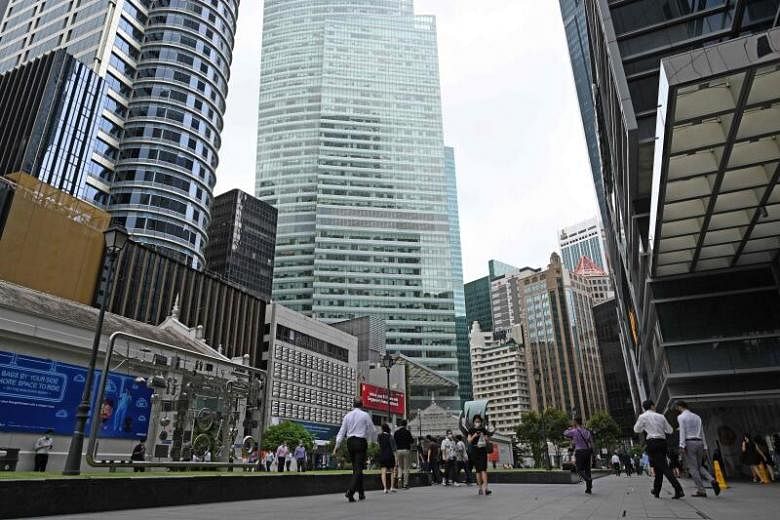Every economic crisis has its aftershocks. History has shown repeatedly that things never return to their pre-crisis state.
The bursting of the stock market and property bubbles in Japan in 1990 led to more than two decades of economic stagnation and the rise of loss-making "zombie companies" that continued to be funded by Japanese banks, which then ran into trouble themselves.
The real estate busts in many European countries around 2010 led to a sovereign debt crisis that engulfed the euro zone.
The Asian financial crisis of 1997 was followed by a long period of corporate restructuring in South Korea, Thailand, Malaysia and Indonesia in which thousands of companies and millions of jobs disappeared.
The economic crisis caused by the Covid-19 pandemic, which is at least as big as any of those listed above, will also have aftershocks affecting companies, workers and governments.
Solvency problems
When it comes to companies, many studies show that as economies start to recover from crises, solvency problems often become more, not less, serious, and this is also likely during the post-Covid-19 recovery.
One recent study by International Monetary Fund (IMF) economists is based on an analysis of 2,600 non-financial firms from six major Asean economies: Indonesia, Malaysia, the Philippines, Singapore, Thailand and Vietnam.
It finds that while the firms did not engage in excessive risk-taking prior to Covid-19, in contrast with the Asian financial crisis of 1997 when property bubbles appeared all over South-east Asia, many of the firms entered the pandemic with high debts. This was because their profitability declined steadily after the global financial crisis of 2008 and borrowing costs rose in the run-up to the pandemic.
Even before the pandemic, about one-third of the firms could not cover their interest payments and a quarter were already "zombie" firms that had debt service problems for at least five years. This was especially true for firms in energy (especially prominent in Singapore's case), materials and consumer discretionary industries such as white goods.
Then came the pandemic. The IMF study points out that had there been no government support, there would have been a wave of corporate bankruptcies: Almost half of the firms would have been unable to cover their interest payments last year and one-third would have run out of cash by the year end.
Masked bankruptcies
But in many countries, bankruptcies were unusually low last year. Despite the worst recession ever, bankruptcy applications in Singapore, which had been rising since 2014, fell more than 18 per cent compared with the pre-Covid year of 2019. This was because of government support in the form of the Jobs Support Scheme (JSS) and other forms of assistance, as well as reliefs from contractual obligations and bank forbearance.
For instance, the minimum threshold for debtors to be exposed to the threat of bankruptcy was quadrupled from $15,000 to $60,000, and they were allowed six months to pay up rather than the 21 days pre-Covid-19. The circuit breaker from April to June might also have prevented bankruptcy proceedings from taking place.
In addition, banks extended repayment moratoriums, letting many companies and individuals off the hook on their dues during the pandemic. In other words, the decline in bankruptcies last year reflected a masking of reality rather than the true state of corporate health.
But this year, the mask will come off. A lot of government support - for example, the JSS - will be ending for most firms by the end of this month. With reliefs from contractual obligations expiring, more creditors will be able to file claims for default, and bank forbearance will also end.
For many firms - and banks - this year will be the moment of truth.
In an interview with me last year, Mr Alfonso Garcia Mora, vice-president for the Asia-Pacific at International Finance Corp - the World Bank's private sector lender - highlighted some of the dangers that lay ahead, and which may materialise this year.
He estimated that after all the temporary support for companies falls away, bankruptcies across the region could rise by as much as 30 per cent. This will have knock-on effects on banks, many of which have not been regularly monitoring the solvency of the borrowers to which they granted repayment holidays.
So when banks open their books this year, they could find that their non-performing loans are not 2 per cent, as in the pre-Covid-19 period, but 20 per cent. About half of troubled firms will not be able to service their loans, Mr Garcia Mora said, which is what the IMF study also estimated.
Another study last year by the Bank for International Settlements (BIS) raises further concerns. It points out that uneven recessions - where corporate distress is concentrated in a small number of industries - could result in more bankruptcies and financial disturbances than recessions in which distress is more evenly spread.
Uneven distress has been the case during the pandemic, in which a few industries such as construction, aviation, tourism, hospitality and events were especially hard hit, whereas the manufacturing, financial services and infocomm sectors fared relatively well.
Unbalanced recessions often result in skill mismatches - skill requirements in the growing sectors can be totally different from those in the hard-hit sectors where the layoffs are concentrated.
There is some evidence of such mismatches in Singapore: A report released last month by the Ministry of Finance revealed that while nearly 76,000 workers found placements under the SGUnited Jobs and Skills Package introduced last May, there were still nearly 130,000 vacancies available at the end of last year.
The BIS study also points out that bankruptcies and unemployment historically lag behind gross domestic product (GDP) growth. They tend to peak around one year after the initial GDP shock and remain elevated for at least another two years.
This suggests that bankruptcies and unemployment will not necessarily fall during an economic recovery that follows an unbalanced recession. The study predicts that bankruptcies in advanced economies could rise by around 20 per cent this year, compared with 2019.
Flattening the insolvency curve
So what can governments do? Experts recommend that during the recovery after the pandemic-induced recession, one of the priorities should be to "flatten the insolvency curve".
According to the IMF, this requires strengthening private debt resolution frameworks and allowing for large-scale corporate debt restructuring. There should be greater reliance on out-of-court settlements for smaller cases, while strengthening formal, in-court debt resolution frameworks for larger cases.
Mr Garcia Mora suggests simplifying methods for smaller firms to declare bankruptcy. He says out-of-court settlements will be especially important in countries where court procedures are cumbersome and lengthy, as is the case in much of South-east Asia.
He also recommends that countries encourage private capital to come in to either buy up troubled companies or create new ventures.
The IMF proposes that banks - which provide most of the credit for Asian companies - should be encouraged to increase lending by maintaining high levels of capital; they might even need to raise some more capital, which will enable them to take more risks. They should also limit dividend payments, which would free up resources for lending.
In addition, governments should encourage equity financing for troubled but viable companies by allowing new forms of funding such as non-voting shares, and selectively injecting public funds into companies, which would also incentivise private capital to come in.
The Singapore Government's initiative, announced in Budget 2021, to co-invest $500 million with Temasek in a Local Enterprises Funding Platform to help large local enterprises expand makes sense, but a similar arrangement for small and medium-sized enterprises should also be considered.
Both the IMF and BIS recommend that other forms of assistance, such as loan guarantees or subsidies, should be confined to viable firms with temporary liquidity problems, as well as firms with good growth prospects. Those with unviable business models that are headed for insolvency should be allowed to exit.
It is not always easy to determine which firms are illiquid and which are insolvent - this is a judgment call - and some companies that are deserving of support might not get it. But that is part of the crisis aftershock that the corporate sector will have to face.
Other aftershocks
There will be other aftershocks too. As insolvencies gather pace and growth companies expand, workers will have to make massive adjustments in moving to new roles and jobs. Recruitment patterns might also change because of changes in the way work is done. For example, the trend of working from home, which became the norm for many professionals during Covid-19, may to a large extent continue post-pandemic.
In Singapore, it turns out that 49 per cent of employed residents worked from home owing to Covid-19, according to the 2020 Labour Force Survey. This proportion was high by world standards and especially high in the information and communications, financial services, education and professional services, which have a high concentration of professionals, managers, executives and technicians.
If these jobs can be done remotely - that is, from anywhere - they could be vulnerable because at least some of them could be done at lower cost by qualified remote workers on online job platforms based elsewhere. The number of such workers has soared during the pandemic.
The persistence of the work-from-home trend post-pandemic could also hurt the land transport and office real estate sectors, which may need to downsize. Ditto for segments of offline retail that have been affected by e-commerce, which is also likely to persist to the extent that consumer purchasing habits have permanently changed.
There could also be global aftershocks. If inflation picks up over the next couple of years in the face of massive monetary and fiscal expansions - and United States bond markets are already flashing warning signs - interest rates in advanced economies could be forced upwards, resulting in a W-shaped recovery, in which a short-term bounceback from the trough of Covid-19 is followed by another leg down.
How exactly things will play out is of course uncertain - every crisis is different, and so is every recovery. But we should heed the lesson from history that emerging from a deep recession is never smooth sailing.


